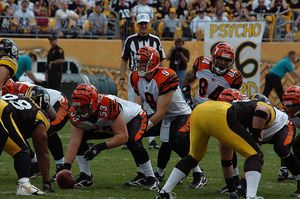After their first playoff appearance in sixteen years, Cincinnati Bengals fans had high hopes for the team in 2006. All eleven offensive starters were back, including arguably the best wide receiver core in football. Carson Palmer’s knee had healed better than even the optimists had hoped. Sam Adams had been acquired to aid a struggling run defense, and safety Madieu Williams was again healthy to administer his patented bone-jarring hits in the secondary. But after December 31st, the Bengals had a record of 8-8 and had missed the playoffs. So what went wrong? How did an up-and-coming team with such talent fall short of its expectations? Below are five factors that contributed to the team’s disappointing season:
1. The Schedule
Cincinnati had the third most difficult schedule in terms of opponent winning percentage when the season began. Among their opponents were both AFC Championship teams, the Colts and Patriots, as well as San Diego, Denver, and New Orleans (the Bengals lost four of these five games). Even the strongest NFL teams would have had trouble with such a schedule.
2. Disciplinary Problems
Following the Bengals in 2006 was like watching a season of Cops. Jonathan Joseph became the ninth Bengal in nine months to be arrested when he was charged with possession of marijuana in late January. Other notables to run into trouble with the law included wide receiver Chris Henry (once for possession of a concealed firearm, once for DUI, and once for the distribution of alcohol to minors), and offensive guard Eric Steinbach (boating – yes, boating – under the influence). It’s difficult to stay focused on the task at hand with so many distractions surrounding the team.
3. Injuries
A defense that struggled the second half of the 2005-06 season was not helped by the slew of injuries in 2006. David Pollack suffered a season-ending, and possibly career-ending, neck injury. Deltha O’Neal was rarely 100 percent and missed four games. The offensive line was broken up for nearly the whole season, with tackle Levi Jones missing ten games and center Rich Braham missing fourteen. In addition, kick returner Tab Perry’s hip problems limited him to two games. A continuously changing lineup was certainly detrimental to the team’s playoff chances.
4. The Defensive Secondary
While the run defense improved considerably from the previous year, the Bengals were tied for last in the NFL with Minnesota in pass defense. Despite intercepting 19 balls, the secondary allowed 24 touchdown passes, a number exceeded by only six teams. Perhaps their most embarrassing performance came in week 15 against the Indianapolis Colts, in which Peyton Mannning completed 29 of 36 passes and threw for four touchdowns. Such a vulnerable secondary puts a lot of pressure on the offense to score, which isn’t easy, even if you are Carson Palmer.
5. Lack of Killer Instinct
As it turned out, all the Bengals had to do was win one of their last three games to make the playoffs with a record of 9-7. They lost at home to the Colts in week 15, lost by a point after a botched point-after attempt in week 16, and lost at home to Pittsburgh in overtime after Shane Graham missed a 37-yard field goal attempt to win the game in week 17. A win in any of those games would have meant a playoff birth. The Bengals just were not mentally tough enough to make the big plays when they had to, the plays that winning teams know how to make, and it cost them a second consecutive trip to the postseason.
While 2006 was a disappointing year for Cincinnati, they still have a bright future. The team boasts one of the most dangerous and versatile offenses in the NFL, and defensive backs Tory James and Kevin Kaesviharn both showed improvement toward the end of the season. They simply need to execute.
Finally, there is the question that more Bengals fans should be asking themselves: can Marvin Lewis turn the franchise into a championship team? The disciplinary problems that plagued the team reflect poorly on his ability to control his players, and Cincinnati often failed to make effective adjustments against opponents in the second half of close games. While some may disagree, this author believes that next season is Lewis’ opportunity to prove himself. Another 8-8 performance will not cut it. Lewis has turned the Bengals, once the lowliest franchise in the NFL, into competitors. Now all he has to do is turn them into winners.

